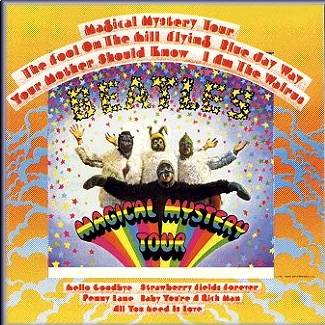
Magical Mystery Tour (1967)

1.Magical Mystery Tour
2.The Fool On The Hill
3.Flying
4.Blue Jay Way
5.Your Mother Should Know
6.I Am The Walrus
7.Hello Goodbye
8.Strawberry Fields Forever
9.Penny Lane
10.Baby You're A Rich Man
11.All You Need Is Love
IIt is perhaps necessary, before assessing Magical Mystery Tour on musical terms, to disentangle the record from its unfortunate cinematic counterpart. Originating as a hastily conceived and poorly received television film, the Magical Mystery Tour project was, at least in Britain, initially presented only as a six-track EP—hardly a full-fledged album. In the United States, however, Capitol Records elected to expand the release into LP format by appending five additional singles recorded during the Sgt. Pepper sessions but left off that album. In time, this expanded version became canonical, and when the Beatles’ catalogue was standardized for CD release in 1987, it was this Capitol variant that was preserved. Rightly so, for its contents far exceed the limitations of its origins.
The film itself—a surrealist pastiche of psychedelic imagery and disconnected vignettes—was met with confusion, even derision. But the music, unburdened by the project’s visual incoherence, reveals a band still in full control of their studio powers, fusing whimsy, wit, and technical ingenuity with characteristic ease. If Sgt. Pepper was the Beatles’ formal statement on the psychedelic era, Magical Mystery Tour is its informal, and at times more vibrant, echo.
The title track opens the record with pomp and color, echoing Sgt. Pepper’s theatrical conceit but with less narrative intent. It is followed immediately by The Fool on the Hill, one of McCartney’s most elegant compositions—gentle in its melody, wistful in tone, and underscored by a sense of isolation that belies its surface simplicity. Lennon’s I Am the Walrus, however, is the album’s true centerpiece—a Dadaist masterpiece constructed from linguistic absurdity, radio samples, backwards strings, and choral punctuation. It remains one of the Beatles’ most enigmatic and densely layered recordings.
Elsewhere, the group ventures into new terrain with Flying, their only credited group instrumental—a brief, looping piece that serves more as a mood than a melody. Blue Jay Way, Harrison’s lone contribution, is another exercise in mood and drone, built on a minor key progression and swirling studio effects. McCartney’s Your Mother Should Know is a turn-of-the-century music hall pastiche, cheerful yet oddly eerie, and further evidence of his deepening fascination with British nostalgia.
If the EP material forms a slightly uneven first act, the second half—composed of non-album singles—elevates the collection substantially. Hello, Goodbye is a shimmering pop confection with an irresistible coda. Strawberry Fields Forever and Penny Lane, though released months earlier as a double A-side, represent the absolute apex of the Beatles’ studio experimentation and melodic invention. That neither appeared on Sgt. Pepper is both baffling and, in hindsight, fortuitous, for their presence here solidifies Magical Mystery Tour as a work of significance.
All You Need Is Love, first broadcast live to an international audience via satellite in 1967, closes the album on a note of grandiloquent idealism. Though occasionally accused of triteness, its singalong structure and layered orchestration embody the spirit—if not the substance—of the Summer of Love. The only true misfire is Baby You’re a Rich Man, a track that, while not without charm, feels slight and unpolished in comparison to its companions. Its inclusion, however, is hardly fatal.
Taken as a whole, Magical Mystery Tour resists easy classification. It is not a concept album, nor a traditional compilation. It is a hybrid, and yet a curiously satisfying one. While its genesis was muddled and its structure unconventional, the music it contains is nothing less than essential. It may have emerged as a patchwork, but it stands—now more than ever—as one of the most colorful and enduring documents of the Beatles’ psychedelic period.